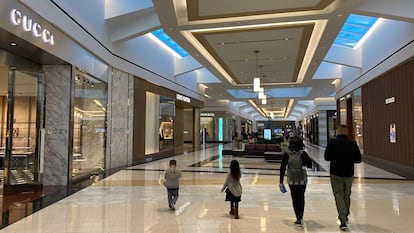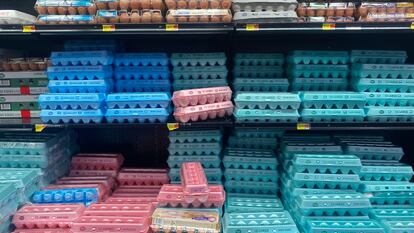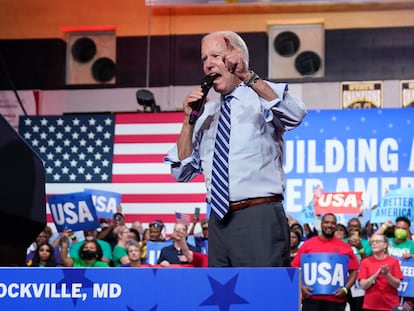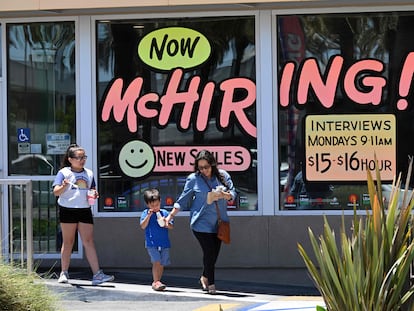King of Prussia: Welcome to ground zero of America’s inflation crisis
The price increases that are hurting the Democrats’ electoral expectations are in plain view at the hundreds of stores in this small town in Pennsylvania


King of Prussia, a small Pennsylvania town of about 22,000 people, has no natural attractions. It has no monuments, no museums and no historical sites that deserve a visit. However, it does have about 30 hotels, many of them of considerable size, which have sprung like mushrooms around the great local tourist attraction: a gigantic shopping mall to which consumers pilgrimage to via the four highways that converge there. However, according to an employee, the hotels are emptier than usual these days. It is not high shopping season yet, but gasoline is more expensive, and fewer people are opting to travel long distances to go shopping. The higher prices – especially of energy and food – are affecting consumption, as well as the expectations of the Democrats ahead of the November 8 midterm elections.
The King of Prussia shopping center is better known than the town with which it shares its unique name, and if you feel like shopping, one day is not enough to visit the entire mall. It is a universe of consumption, with more than 450 establishments that occupy a total of about 2.9 million square feet. Fashion stores (from Primark to Ralph Lauren), luxury stores (Jimmy Choo, Louis Vuitton, Gucci, Tiffany’s, Bulgari, Cartier), department stores (Bloomingdale’s, Macy’s), decoration, home, furniture, sports stores... you can even find a Tesla dealer and dozens of restaurants. In the immediate vicinity, there are a multitude of other stores, supermarkets and megastores. Costco and Walmart, the giants of food distribution, are there. And of course, there are several gas stations within walking distance of the shopping center. It’s home to practically the entire universe of American consumption.
“It’s on Saturdays when it gets crowded,” said one store’s employee. Although it shows signs of weakness, so far, consumption has resisted to a surprising degree, thanks to savings accumulated during the pandemic and the strength of the labor market.
That is another paradox of the American economy. The unemployment rate is 3.5%, the lowest in 50 years. “Help wanted” signs can be seen in numerous King of Prussia stores. It is estimated that the number of offers is double the number of unemployed. US President Joe Biden recently stated that the country has “employed 10 million additional workers. More than any time at all. Unemployment is the second-lowest rate in all of American history.”
More hot dogs
But the truth is more complex. Unemployment has simply returned to its pre-pandemic level. Inflation, however, was an almost forgotten problem for the Americans. In the last 30 years, the average had been slightly above 2%. Until the current crisis, that is. In order to overcome the pandemic, the Federal Reserve and the Biden administration flooded the economy with liquidity and demand soared, while supply continued to be mired by supply chain problems and Covid-19 restrictions. What’s more, these problems were aggravated by the war in Ukraine, due to its impact on oil, food and other raw materials. Prices are now rising at their fastest rate in four decades. Inflation reached 9.1% in June, and it refuses to go down. In September – the latest data prior to the midterm elections – it stood at 8.2%.
“Everything is expensive, but you have to eat,” said a customer, smiling as she left the King of Prussia Walmart with her children recently. According to the United States Bureau of Labor Statistics, the food for home consumption has become 13% more expensive in the last 12 months. This includes steep increases in basic products such as eggs (30.5%), milk (15.2%), chicken (17.2%), rice and pasta (15.9%) and margarine (44%). Walmart’s chief financial officer explained recently that the customers are shifting towards cheaper products, such as hot dogs, canned tuna and chicken.

Meanwhile, gasoline is still up 18% year-on-year, and the bills that arrive at home are also increasingly higher: electricity is up 15.5% and gas 33%.
Compared to that, the 5.5% increase in clothing (the most sought-after product at the King of Prussia mall) is not much. Sales and discounts have managed to contain the prices. For the retail sector, the problem is different: if consumers spend more on food, they have less money for other purchases. Companies miscalculated and found themselves with a lot of stock that they could not sell.
The Federal Reserve is trying to contain inflation with the most aggressive interest rate hikes since the 1980s. Its chairman, Jerome Powell, has said it will take “some pain” to contain the problem; he is also willing to provoke a recession if necessary. Monetary tightening and the prospect of an economic slowdown have hit the Stock Market, in which tens of millions of Americans invest, directly or indirectly.
The rate increases have especially affected mortgages, which are already around 7% for 30-year loans, according to Freddie Mac. With that, home sales plummet; just last Thursday, the Pennsylvania Association of Realtors pointed out that, in their state, they had fallen 16% year-on-year.
What worries the public most
In polls, the economy in general, and inflation in particular, invariably appear as the main problem, far behind immigration, abortion, crime, firearms or threats to democracy. In the most recent The New York Times / Siena poll, the economy in general is the most important problem for 26% of likely voters and inflation for 18%. Abortion and immigration are mentioned by 5%. In Gallup’s poll, 38% cite economic issues, 22% see the government as a problem and immigration is the third concern, with 6%. And according to the CBS News / YouGov poll, 65% of voters believe the economy is getting worse, with the majority blaming Biden for the problem.
“It’s the economy, stupid.” That is the phrase that James Carville, Bill Clinton’s strategist, used as the core of the 1992 presidential campaign to defeat George Bush Sr. The Republicans are convinced that it is also the one that will give them the victory at the midterm elections. At every debate and rally, they draw blood with the price hikes, trying to hold Biden accountable and tie the Democratic candidates to him.
The president secured passage for his “Inflation Reduction Act.” But while the law has not brought down inflation, it has at least given him some political ammunition. Biden also challenged the directors of the oil companies to lower gasoline prices, while announcing that he will continue to put more strategic oil reserves on the market. It hasn’t done him much good.
At least the slowdown in the labor market and the potential recession have been delayed. Saturdays, Thanksgiving weekend (with Black Friday) and the weeks leading up to Christmas are the times when the King of Prussia shopping center is packed. Those dates will be this year’s acid test, which will determine where consumption and the US economy are headed. But that will happen after the November 8 elections.
Tu suscripción se está usando en otro dispositivo
¿Quieres añadir otro usuario a tu suscripción?
Si continúas leyendo en este dispositivo, no se podrá leer en el otro.
FlechaTu suscripción se está usando en otro dispositivo y solo puedes acceder a EL PAÍS desde un dispositivo a la vez.
Si quieres compartir tu cuenta, cambia tu suscripción a la modalidad Premium, así podrás añadir otro usuario. Cada uno accederá con su propia cuenta de email, lo que os permitirá personalizar vuestra experiencia en EL PAÍS.
¿Tienes una suscripción de empresa? Accede aquí para contratar más cuentas.
En el caso de no saber quién está usando tu cuenta, te recomendamos cambiar tu contraseña aquí.
Si decides continuar compartiendo tu cuenta, este mensaje se mostrará en tu dispositivo y en el de la otra persona que está usando tu cuenta de forma indefinida, afectando a tu experiencia de lectura. Puedes consultar aquí los términos y condiciones de la suscripción digital.
More information
Archived In
Últimas noticias
Welcome to the post-religion era: The idea of Christianity as the absolute truth has become obsolete
‘I thought you would like it’: The risky sexual practice popularized by TV shows and TikTok
The digitalization of tourism: ‘They promise experiences and gave us the worst possible one’
Mexican peso defies uncertainty with forecasts of a new period of stability in 2026
Most viewed
- Sinaloa Cartel war is taking its toll on Los Chapitos
- Oona Chaplin: ‘I told James Cameron that I was living in a treehouse and starting a permaculture project with a friend’
- Reinhard Genzel, Nobel laureate in physics: ‘One-minute videos will never give you the truth’
- Why the price of coffee has skyrocketed: from Brazilian plantations to specialty coffee houses
- Silver prices are going crazy: This is what’s fueling the rally










































